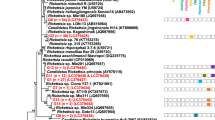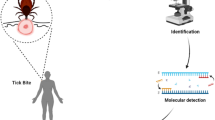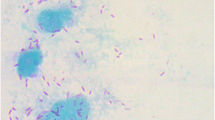Abstract
Two rickettsial isolates recovered fromIxodes ricinus ticks in Puy-de-Dôme (Central France) were characterized by sodium dodecyl sulfate-polyacrylamide gel electrophoresis, Western blot immunoassay, restriction fragment length polymorphism analysis, and sequencing of a portion of the citrate-synthase gene. By these methods, the isolates appeared to be identical to a member of the spotted fever group rickettsiae,Rickettsia helvetica. This first isolation ofRickettsia helvetica in France has epidemiologic importance; a serosurvey on Mediterranean spotted fever conducted previously in Puy-de-Dôme, where the infection is not endemic, demonstrated a high seroprevalence of nonspecific antibodies directed against spotted fever group rickettsiae lipopolysaccharides, and thus the possibility of infection due to a rickettsia different fromRickettsia conorii was suggested. The isolation ofRickettsia helvetica in anthropophilic ticks in the same area further supports this hypothesis.
Similar content being viewed by others
References
Burgdorfer W, Varma MGR: Trans-stadial and transovarial development of disease agents in arthropods. In: Smith RF, Mittler TE (eds) Annual reviews of entomology. Annual Reviews, Palo Alto, Calif, (1967) pp 347–376
Gilot B, Laforge ML, Pichot J, Raoult D: Relationships between theRhipicephalus sanguineus complex ecology and Mediterranean spotted fever epidemiology in France. European Journal of Epidemiology (1990) 6:357–362
Eremeeva M, Balayeva NM, Ignatovich V, Raoult D: Proteinic and genomic identification of spotted fever group rickettsiae isolated in the former USSR. Journal of Clinical Microbiology (1993) 31:2625–2633
Tarasevich IV, Makarova V, Fetisova NF, Stepanov A, Mistkarova E, Balayeva NM, Raoult D: Astrakhan fever: new spotted fever group rickettsiosis. Lancet (1991) 337:172–173
Eremeeva M, Balayeva NM, Ignatovich V, Raoult D: Genomic study ofRickettsia akari by pulsed-field gel electrophoresis. Journal of Clinical Microbiology (1995) 33:3022–3024
Radulovic S, Feng HM, Morovic M, Djelalija D, Popov V, Crocquetvaldes P, Walker DH: Isolation ofRickettsia akari from a patient in a region where Mediterranean spotted fever is endemic. Clinical Infectious Diseases (1996) 22:216–220
Raoult D, Brouqui P, Roux V: A new spotted fever group rickettsiosis. Lancet (1996) 348:412
Raoult D, Berbis P, Roux V, Maurin M, Xu W, Capo C: A new tick transmitted disease caused byRickettsia slovaca. Lancet (1997) 350:112–113
Burgdorfer W, Aeschlimann A, Peter O, Hayes SF, Philip RN:Ixodes ricinus vector of a hitherto undescribed spotted fever group agent in Switzerland. Acta Tropica (1979) 36:357–367
Nilsson K, Jaenson TGT, Uhnoo I, Lindquist O, Pettersson B, Uhlen M, Friman G, Pahlson C: Characterisation of a spotted fever group rickettsia fromIxodes ricinus ticks in Sweden. Journal of Clinical Microbiology (1997) 35:243–247
Drancourt M, Kelly P, Regnery R, Raoult D: Identification of spotted fever group rickettsiae using polymerase chain reaction and restriction-endonuclease length polymorphism. Acta Virologica (1992) 36:1–6
Bead L, Finidori JP, Gilot B Raoult D: Comparison of serologic typing, sodium dodecyl sulfate-polyacrylamide gel electrophoresis protein analysis, and genetic restriction fragment length polymorphism analysis for identification of rickettsiae: characterization of two new rickettsial strains. Journal of Clinical Microbiology (1992) 30:1922–1930
Bacellar F, Regnery RL, Nuncio MS, Filipe AR: Genotypic evaluation of rickettsial isolates recovered from various species of ticks in Portugal. Epidemiology and Infection (1995) 114:169–178
Babalis T, Tselentis Y, Roux V, Psaroulaki A, Raoult D: Isolation and identification of a rickettsial strain related toRickettsia massiliae in Greek ticks. American Journal of Tropical Medicine and Hygiene (1994) 50:365–372
Beati L, Roux V, Ortuno A, Castella J, Segura Porta F, Raoult D: Phenotypic and genotypic characterization of spotted fever group rickettsiae isolated from CatalanRhipicephalus sanguineus ticks. Journal of Clinical Microbiology (1996) 34:2688–2694
Raoult D, Arzouni JP, Jambon MC, Beytout J, Ramousse O: Western blot as a seroepidemiologic tool for detecting foci of Mediterranean spotted fever (MSF). European Journal of Epidemiology (1994) 10:37–40
Gilot B, Guigen C, Degeilh B, Doche B, Pichot J, Beaucournu JC: Phytoecological mapping ofIxodes ricinus as an approach of the distribution ofLyme borreliosis in France. In: Axford JS, Rees DHE (ed) Lyme borreliosis (NATO meeting). Plenum Press, New York, (1994) pp 105–112
Nosek J, Sixl W: Central-European ticks (Ixodidea). Key for determination. Mitteilungen der Abteilung fur Zoologie am Landesmuseum Joanneum (1982) 2:61–92
Gimenez DF: Staining rickettsiae in yolk-sac cultures. Stain Technology (1964) 39:135–140
Regnery RL, Spruill CL, Plikaytis BD: Genomic identification of rickettsiae and estimation of intraspecies sequence divergence for portions of two rickettsial genes. Journal of Bacteriology (1991) 173:1576–1589
Philip RN, Casper EA, Burgdorfer W, Gerloff RK, Hugues LE, Bell EJ: Serologic typing of rickettsiae of the spotted fever group by microimmunofluoresence. Journal of Immunology (1978) 121:1961–1968
Beati L, Humair PF, Aeschlimann A, Raoult D: Identification of spotted fever group rickettsiae isolated fromDermacentor marginatus andIxodes ricinus ticks collected in Switzerland. American Journal of Tropical Medicine and Hygiene (1994) 51:138–148
Laemmli UK: Cleavage of structural proteins during the assembly of the head bacteriophage T4. Nature (1970) 227:680–685
Roux V, Rydkina E, Eremeeva M, Raoult D: Citrate synthase gene comparison, a new tool for phylogenic analysis, theRickettsia paradigm. International Journal of Systematic Bacteriology (1997) 47:252–261
Dessen P, Fondrat C, Valencien C, Munier G: BISANCE: a French service for access to biomolecular sequences databases. Computer Applications in the Biosciences (1990) 6:355–356
Beati L, Peter O, Burgdorfer W, Aeschlimann A, Raoult D: Confirmation thatRickettsia helvetica sp. nov. is a distinct species of the spotted fever group of rickettsiae. International Journal of Systematic Bacteriology (1993) 43:521–526
Gilot B, Degueilh B, Pichot J, Doche B, Guigen C: Prevalence ofBorrelia burgdorferi (sensu lato) inIxodes ricinus (L.) populations in France according to a phytoecological zoning of the territory. European Journal of Epidemiology (1996) 12:395–401
Peter O, Burgdorfer W, Aeschlimann A: Enquête épidémiologique dans un foyer naturel de Rickettsies àIxodes ricinus du plateau Suisse. Annales de Parasitologie Humaine et Comparée (1981) 56:1–8
Peter O: Presence d'anticorps contre la “Rickettsie suisse” chez les mammifères sauvages et domestiques du canton de Neuchatel. Schweizer Archiv fur Tierheilkunde (1985) 127:461–468
Teysseire N, Raoult D: Comparison of Western immunoblotting and microimmunofluorescence for diagnosis of Mediterranean spotted fever. Nature (1992) 30:455–460
Raoult D, Dasch GA: Line blot and Western blot immunoassays for diagnosis of Mediterranean spotted fever. Journal of Clinical Microbiology (1989) 27:2073–2079
Davis GE, Cox HR: A filter passing infectious agent isolated from ticks. Isolation fromD. Andersoni, reaction in animals and filtration experiments. Public Health Reports (1938) 53:2259–2267
Beati L, Finidori JP, Raoult D: First isolation ofRickettsia slovaca fromDermacentor marginatus in France. American Journal of Tropical Medicine and Hygiene (1993) 48:257–268
Rehacek J:Rickettsia slovaca, the organism and its ecology. Acta Scientiarum Naturalium Academiae Scientiarum Bohemoslovacae (Brno) (1984) 18:1–50
Author information
Authors and Affiliations
Rights and permissions
About this article
Cite this article
Parola, P., Beati, L., Cambon, M. et al. First isolation ofRickettsia helvetica fromIxodes ricinus ticks in France. Eur. J. Clin. Microbiol. Infect. Dis. 17, 95–100 (1998). https://doi.org/10.1007/BF01682163
Issue Date:
DOI: https://doi.org/10.1007/BF01682163




